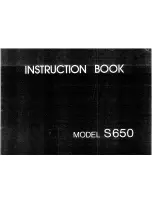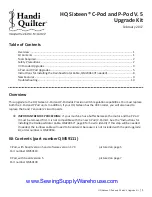
thread the needle.
2- Lower bobbin (E)
Press the button to open the lid (25) at the back of the sewing machine. (If
necessary, use a small object to pry the lid open). Place the bobbin in the
magnetized compartment, turn the bobbin clockwise and cut the thread leaving
approximately 5 cm free. Replace the lid. Place the free thread under the
presser foot.
4. POSITIONING THE FABRIC AND STARTING UP
1- Turn the handwheel in the direction of the arrow to lift the needle as far up as
it will go.
2- Push the presser-foot lever (14) up and position the fabric so that the thread
of the lower bobbin is under the fabric and that of the upper bobbin is above it.
3- Lower the presser-foot lever.
4- Turn the handwheel round 2 or 3 times in the direction of the arrow to check
that the fabric and needle move correctly.
5- Turn the sewing machine ON with the ON/OFF button and you’re ready to
start sewing. If you prefer, you can plug the foot pedal to the pedal socket (23)
and activate the machine by stepping on the foot pedal.
6- Select the desired speed with the speed regulator (2).
7- When you have finished sewing, turn the machine OFF with the ON/OFF
button. Turn the handwheel to lift the needle up, lift the presser-foot lever (14) to
release the fabric and cut the thread.
(N.B.: If the fabric is not easily released, turn the handwheel gently backwards
and forwards until it can be removed.)
5. REGULATING THE THREAD TENSION
As shown in the illustration, the upper and lower threads should normally be
equally tense: not too tight or too loose.
If the stitches on the lower face of the fabric are just a straight line of thread, it
means that the upper thread is too loose. To correct this, tense the upper thread
by turning the tension unit (9) clockwise until the stitches become regular. (F)
If the stitches on the upper face of the fabric are just a straight line of thread, it
means that the upper thread is too tense. Loosen the upper thread by turning
the tension unit (9) anticlockwise until the stitches become regular. (G)
(N.B.: When regulating the thread tension, make sure that the upper thread
does not come out of the needle. If it does, just rethread it.)
6. BOBBIN WINDING (H)
To fill an empty bobbin, place it on the bobbin-winding spindle (3) hidden inside
the handwheel (4) and proceed as follows:
1- Extract the bobbin-winding spindle by pressing it and turning it in the direction
of the arrow. It will come out automatically.
2- Place the empty bobbin on the spindle and turn it round clockwise 4 or 5
times.
3- Place the spool of thread on the spool spindle (8).
4- Insert the thread through the small hole in the bobbin, from the inside
outwards, leaving a small amount of thread projecting from the hole so that it
can be easily held.
5- Turn the machine ON and start filling the bobbin while holding the thread as
shown in the photo.
6- When the bobbin is full, turn the machine OFF by pressing the ON/OFF
button.
7- Cut the thread and remove the bobbin and spool.
8- Insert the bobbin-winding spindle back into the handwheel and turn clockwise
to secure it there.
7. CHANGING THE NEEDLE
Proceed as follows if you need to replace a broken needle or want to change the
needle:
1- To prevent any accidents from happening, remove the batteries from their
compartment or unplug the machine from the wall socket.
2- Turn the handwheel to lift the needle as far as it will go.
3- Loosen the needle-bar screw (20) and pull the needle down to remove it.
4- Insert the new needle in the needle bar and push up as far as it will go.
5- Tighten the needle-bar screw while holding the needle in place.
(N.B.: To avoid accidents, make sure that the screw is tightened clockwise.)
8. USING THE NEEDLE THREADER
Simply pass the threader wire through the eye in the needle, then pass the
thread through the centre of the loop made by the wire and withdraw the
threader.
9. CONNECTING THE ADAPTER
The adapter power should be 6VDC, 800 MA. Its voltage should correspond to
the AC voltage. Insert the adapter plug into the corresponding socket in the
machine.
(N.B.: Before connecting the adapter, ensure that the ON/OFF button is in the
OFF position.)
TROUBLESHOOTING GUIDE
PROBLEM
POSSIBLE CAUSE
SOLUTION
The sewing machine
does not work when the
ON/OFF button is in the
ON position
Batteries incorrectly
installed
Batteries run out
Old and new batteries
mixed
Install correctly
Change batteries
Use only new ones
Summary of Contents for SEW WHIZ
Page 2: ......
Page 3: ...A E F H G B C D...






































